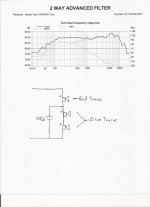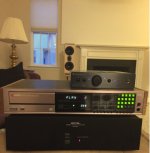I do not intend to use the TMMM with all Ms going up to meet the tweeter. Only the upper one will. The lower 2 will be rolled off above 300 Hz in a series circuit with a large capacitor bypassing the lower 2. The attached sketch shows the configuration with a graph from an LspCAD sim showing the relative and additive response.
Attachments
Some inherent directivity problem is common issue with multi-ways without coaxial driver anyway. Also MT has some lobing and power drop at the crossover range without phase mismatching or other tricks because M-T distance is usually 1/2...1/1 of wave length at the x/o frequency.
But if more vertical directivity at midrange is needed and wanted, and MTM or TMM is selected for the job, that should be done as good as possible I guess. Not by beauty or what personal guru writes on diyaudio. Target is high and extended total directivity (DI) without lobing problems within defined/normal listening window in vertical plane, and smooth axial and power response which is equal to smooth directivity index response. Usable range of drivers (non-linearities) shouldn't be exceeded of course.
I would measure MT prototype with selected or compatible drivers. Then simulate and optimize both MTM and TMM before making final decision and speakers.
Simulator should be able to calculate and visualize axial, power and off-axis responses in vertical plane. At least LspCAD 6 and VituixCAD are valid tools. The last one calculates also DI response which helps defining initial values for crossover optimizing.
But if more vertical directivity at midrange is needed and wanted, and MTM or TMM is selected for the job, that should be done as good as possible I guess. Not by beauty or what personal guru writes on diyaudio. Target is high and extended total directivity (DI) without lobing problems within defined/normal listening window in vertical plane, and smooth axial and power response which is equal to smooth directivity index response. Usable range of drivers (non-linearities) shouldn't be exceeded of course.
I would measure MT prototype with selected or compatible drivers. Then simulate and optimize both MTM and TMM before making final decision and speakers.
Simulator should be able to calculate and visualize axial, power and off-axis responses in vertical plane. At least LspCAD 6 and VituixCAD are valid tools. The last one calculates also DI response which helps defining initial values for crossover optimizing.
MTM driver placement- having the woofers close coupled to one side and the tweeter offset(but close to both)- are there any issues with this layout
A lot to love about these two designs, small and powerful mainly.
MTM's sound like one is looking down a pipe, lol, I don't think so, the last modification to the mtm xo is wonderful!!
Some of my mtm experiments did do that, so I know Norm is saying. Those boxes are cut up and long gone now.
Say tuned....
MTM's sound like one is looking down a pipe, lol, I don't think so, the last modification to the mtm xo is wonderful!!
Some of my mtm experiments did do that, so I know Norm is saying. Those boxes are cut up and long gone now.
Say tuned....
MTM driver placement- having the woofers close coupled to one side and the tweeter offset(but close to both)- are there any issues with this layout
Directivity is probably quite concentrated at the x/o frequency and slightly below. Some lobing might exists in horizontal plane. Otherwise it's kinda mix of both MTM and TMM. Impossible to say is it better or worse than plain MTM and TMM with the same drivers.
I'd never cross an mtm or tmm above 2khz anywayDirectivity is probably quite concentrated at the x/o frequency and slightly below. Some lobing might exists in horizontal plane. Otherwise it's kinda mix of both MTM and TMM. Impossible to say is it better or worse than plain MTM and TMM with the same drivers.
My thoughts exactly.
Btw, when I swept the speaker right before installation, I could not hear the xo point.
Btw, when I swept the speaker right before installation, I could not hear the xo point.
I'd never cross an mtm or tmm above 2khz anyway
I made quick and dirty simulation with horizontal offset of tweeter crossed just below 2 kHz. That doesn't look very promising. DI and power response curves could be quite difficult to handle.
Theres a build over on tech talk forum using a wavecor tweet and anarchy woofers MTM (pete schumacher)
Looks nice!
Looks nice!
Hello, my name is Hanze.
I find your conversation very interesting, and perhaps/ or not, I have something to contribute.
With respect to driver selection and cross-over, also with stepped baffles and time/phase collaboration for a single point source using a 6dB first order XO.
Have an old pair (must be 20 years) MTM. Just a single cap to the tweeter and a small resistor (less than 8R//56R) to the paralleled mids. Seas Excel T25 tweeter and Vifa P13 mids. No inductor in the cross-over at all.
I am owner and have the manual, they claim phase response with 25 degrees across the audio band.
My question, if you will - how did they accomplish MTM without inductor to the paralleled "M's"?.
With thanks, and interest.
Hanze.
I find your conversation very interesting, and perhaps/ or not, I have something to contribute.
With respect to driver selection and cross-over, also with stepped baffles and time/phase collaboration for a single point source using a 6dB first order XO.
Have an old pair (must be 20 years) MTM. Just a single cap to the tweeter and a small resistor (less than 8R//56R) to the paralleled mids. Seas Excel T25 tweeter and Vifa P13 mids. No inductor in the cross-over at all.
I am owner and have the manual, they claim phase response with 25 degrees across the audio band.
My question, if you will - how did they accomplish MTM without inductor to the paralleled "M's"?.
With thanks, and interest.
Hanze.
Well "MTM" is about the physical placement of drivers but nothing is implied about filter, so...
//
//
Topic is MTM vs TMM, I suspect the outcome would be very well based on driver selection, enclosure and baffle design, and of course the crossover.
Thank you.
Thank you.
Tighter spacing between the tweeter and the midrange/midbass line improves this situation.
If you can get centre-to-centre to a quarter wavelength at the XO point the issues almost all go away. Wired in phase it is as if the drivers are coincident.
dave
Oops still here (no emails notifications)
Norm, the xo are very similar.
We have one thing in common, always trying new gear/configurations.
This combination was unbelievable - put on your seatbelt plz.
This vintage 880 has plenty of life in it, the kettle drums are amazing.
[mini DAC is very convenient, for fast hookup, and also has preamp functions]
Sounds like the National Symphony Orchestra at the Kennedy Center.
Which reminds of my story about falling backward into the orchestra pit at KC, true story, but I'll save that for another day.
Norm, the xo are very similar.
We have one thing in common, always trying new gear/configurations.
This combination was unbelievable - put on your seatbelt plz.
This vintage 880 has plenty of life in it, the kettle drums are amazing.
[mini DAC is very convenient, for fast hookup, and also has preamp functions]
Sounds like the National Symphony Orchestra at the Kennedy Center.
Which reminds of my story about falling backward into the orchestra pit at KC, true story, but I'll save that for another day.
Attachments
I just question why the tweeter seems to be turned up vertically on the MTM as compared to the TMM If as Dave says above "the spacing to 1/4 wavelength at Xover" is better. Was this a woodworking thing? Or is the tweeter that way for a sound reason?
Borus and Friends,
Tweeter orientation is purely for aesthetics, PE sent extra face plates back then.
Getting back to the OP, I consistently circle back around to MTM's, I don't believe they are the best design for off axis seating, but that is low on my priority list.
Also the shout-out about the affordable Anarchy woofers, some may think they are old new but I don't see how they didn't make it to other build lists, four of these in a listening room is quite astonishing.
Next build...the Apollo!
Tweeter orientation is purely for aesthetics, PE sent extra face plates back then.
Getting back to the OP, I consistently circle back around to MTM's, I don't believe they are the best design for off axis seating, but that is low on my priority list.
Also the shout-out about the affordable Anarchy woofers, some may think they are old new but I don't see how they didn't make it to other build lists, four of these in a listening room is quite astonishing.
Next build...the Apollo!
Can I pull off a 2khz crossover 7-8' away ?
2 x 6.5" drivers (7" frame) using an mtm (3" frame tweet).
I'm thinking of making something similar to the Dunlavy sm1.
Time aligned, 6db crossover (my favorite).
Its tweeter is shifted back for time alignment.
Dunlavy SM 1 Floorstanding Speakers user reviews : 5 out of 5 - 8 reviews - audioreview.com
Dunlavy SM-1. - Free Online Library
I know ideally I'd use smaller drivers and a micro tweet for a true point source.
But I need some cone area for my music tastes.
Jon
2 x 6.5" drivers (7" frame) using an mtm (3" frame tweet).
I'm thinking of making something similar to the Dunlavy sm1.
Time aligned, 6db crossover (my favorite).
Its tweeter is shifted back for time alignment.
Dunlavy SM 1 Floorstanding Speakers user reviews : 5 out of 5 - 8 reviews - audioreview.com
Dunlavy SM-1. - Free Online Library
I know ideally I'd use smaller drivers and a micro tweet for a true point source.
But I need some cone area for my music tastes.
Jon
Last edited:
- Status
- Not open for further replies.
- Home
- Loudspeakers
- Multi-Way
- MTM - TMM Shoot Out

